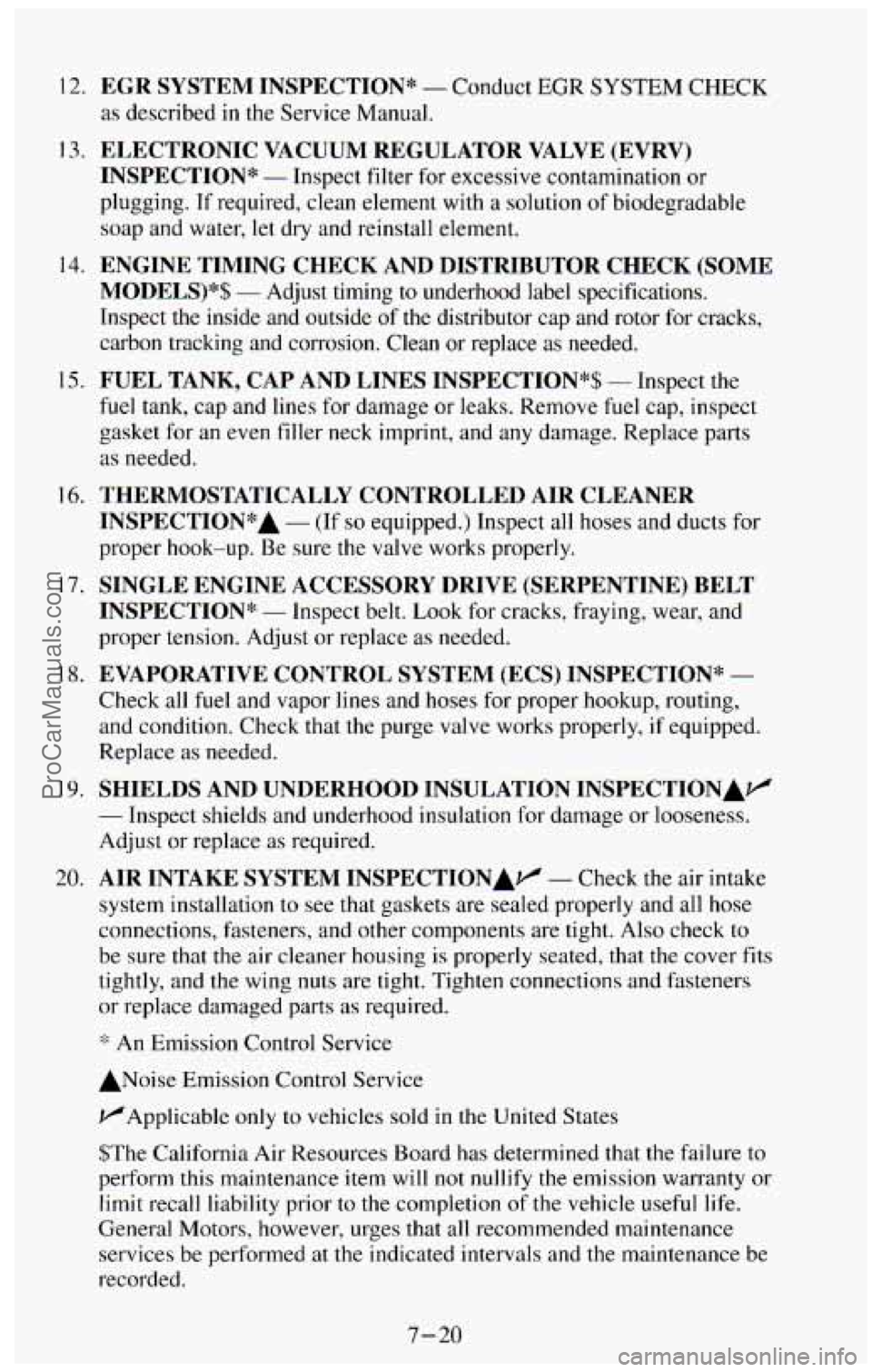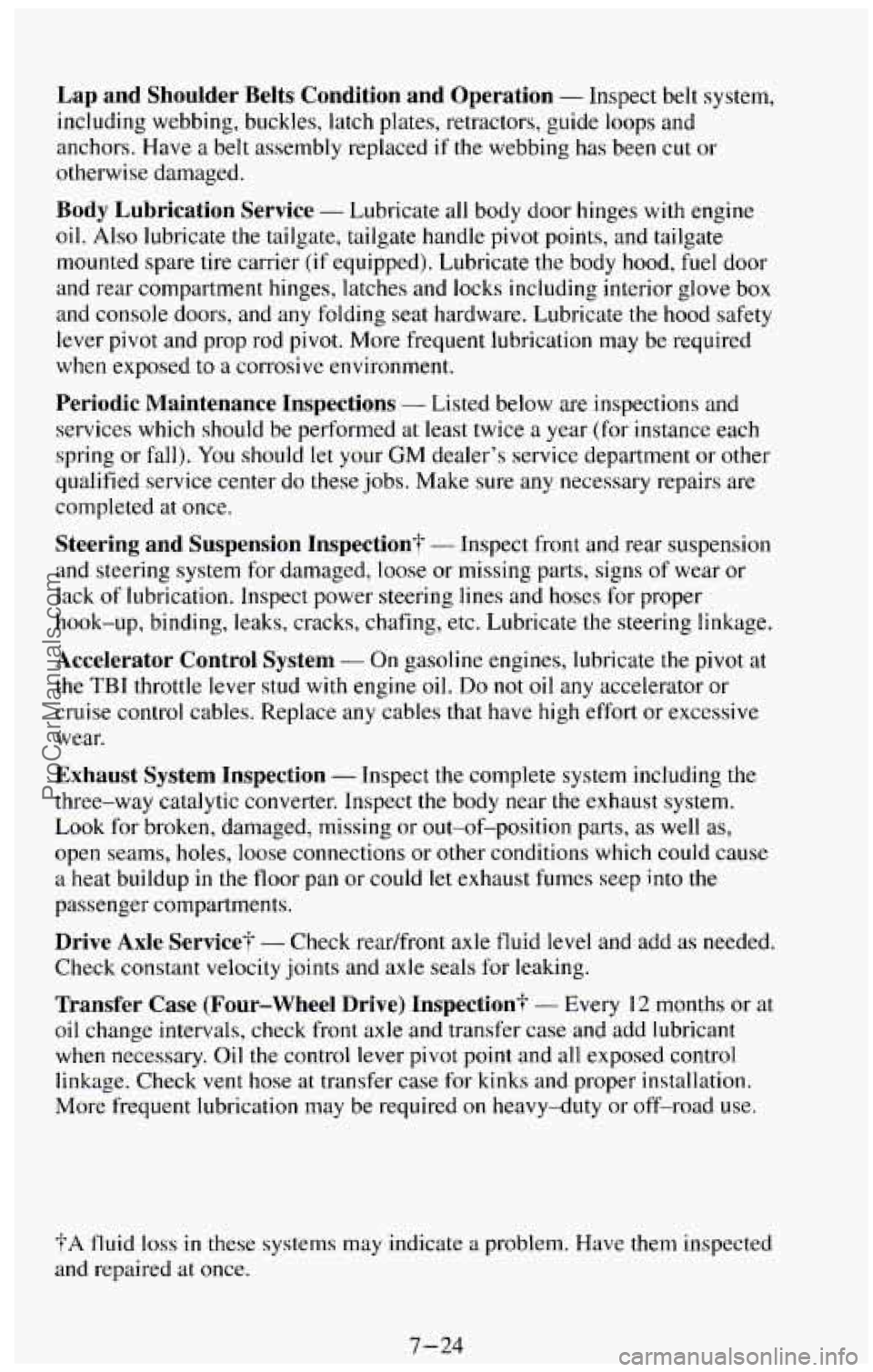Page 352 of 385

7. TRANSMISSION SERVICE;-
Automatic Transmission
- Change the transmission fluid and filter
every 15,000 miles
(25 000 km) for vehicles under 8,600 GVWR or
every 12,000 miles
(20 000 km) for vehicles over 8,600 GVWR if the
vehicle
is mainly driven under one or more of these conditions:
In heavy city traffic.
0 Where the outside temperature regularly reaches 90°F (32°C) or
higher.
In hilly or mountainous terrain.
Frequent trailer pulling.
0 Uses such as taxi, police, delivery or other commercial service.
If the vehicle is not used mainly under any
of these conditions, change
the fluid and filter every
30,000 miles (50 000 km) for vehicles under
8,600 GVWR or every 24,000 miles (40 000 km) for vehicles over
8,600 GVWR see “Automatic Transmission Fluid” in the Index for
more information.
Manual Transmission - Transmission fluid does not require periodic
changing.
8. CDRV SYSTEM INSPECTION* - Check the Crankcase
Depression Regulator Valve System for
any worn, plugged or collapsed
hoses. Have the system checked as described in the Service Manual.
9. FUEL FILTER REPLACEMENT*$ - Replace the fuel filter at the
specified interval or sooner if clogged.
10. SPARK PLUG REPLACEMENT* - Replace spark plugs with the
type listed in Section
6. See “Specification Charts” in the Index.
1 1. SPARK PLUG WIRE INSPECTION - Clean wires and inspect for
burns, cracks or other damage. Check the wire boot fit at the distributor
and at the
spark plugs. Replace wires as needed.
‘% An Emission Control Service
$The California Air Resources Board has determined that the failure to
perform this maintenance item will
not nullify the emission warranty or
limit recall liability prior to the completion of the vehicle useful life.
General Motors, however, urges that all recommended maintenance
services be performed at the indicated intervals and the maintenance be
recorded.
?A fluid loss in
these systems may indicate a problem. Have them
inspected and repaired at once.
7-19 ProCarManuals.com
Page 353 of 385

12.
13.
14.
15.
16.
17.
18.
19.
20.
EGR SYSTEM INSPECTION* - Conduct EGR SYSTEM CHECK
as described in the Service Manual.
ELECTRONIC VACUUM REGULATOR VALVE (EVRV)
INSPECTION*
- Inspect filter for excessive contamination or
plugging. If required, clean element with a solution of biodegradable
soap and water, let dry and reinstall element.
ENGINE TIMING CHECK AND DISTRIBUTOR CHECK (SOME
MODELS)*$
- Adjust timing to underhood label specifications.
Inspect
the inside and outside of the distributor cap and rotor for cracks,
carbon tracking and corrosion. Clean
or replace as needed,
FUEL TANK, CAP AND LINES INSPECTION*$ - Inspect the
fuel tank, cap and lines for damage or leaks. Remove fuel cap, inspect
gasket for an even filler neck imprint, and any damage. Replace parts
as needed.
THERMOSTATICALLY CONTROLLED AIR CLEANER
INSPECTION*A
- (If so equipped.) Inspect all hoses and ducts for
proper hook-up.
Be sure the valve works properly.
SINGLE ENGINE ACCESSORY DRIVE (SERPENTINE) BELT
INSPECTION*
- Inspect belt. Look for cracks, fraying, wear, and
proper tension. Adjust or replace
as needed.
Check all
fuel and vapor lines and hoses for proper hookup, routing,
and condition. Check that the purge valve works properly,
if equipped.
Replace as needed.
SHIELDS AND UNDERHOOD INSULATION INSPECTIONAV
- Inspect shields and underhood insulation for damage or looseness.
Adjust or replace
as required.
AIR INTAKE SYSTEM INSPECTIONAV - Check the air intake
system installation to see that gaskets are sealed properly and all hose
connections, fasteners, and other components are tight. Also check to
be sure that
the air cleaner housing is properly seated, that the cover fits
tightly, and the wing nuts are tight. Tighten connections and fasteners
or replace damaged parts
as required.
'% An Emission Control Service
ANoise Emission Control Service
P'Applicable only to vehicles sold
in the United States
$The California Air Resources Board
has determined that the failure to
perform this maintenance item will not nullify
the emission warranty or
limit recall liability prior to the completion of the vehicle \
useful life.
General Motors, however, urges that
all recommended maintenance
services be performed at the indicated intervals and the maintenance be \
recorded.
EVAPORATIVE CONTROL SYSTEM (ECS) INSPECTION* -
7-20
ProCarManuals.com
Page 357 of 385

Lap and Shoulder Belts Condition and Operation - Inspect belt system,
including webbing, buckles, latch plates, retractors, guide loops\
and
anchors. Have
a belt assembly replaced if the webbing has been cut or
otherwise damaged.
Body Lubrication Service - Lubricate all body door hinges with engine
oil.
Also lubricate the tailgate, tailgate handle pivot points, and tailgate
mounted spare tire carrier (if equipped). Lubricate the body hood,
fuel door
and rear compartment hinges, latches and locks including interior glove box
and console doors, and any folding seat hardware. Lubricate the hood safety
lever pivot and prop rod pivot. More frequent lubrication may be required
when exposed to
a corrosive environment.
Periodic Maintenance Inspections - Listed below are inspections and
services which should be performed at least twice
a year (for instance each
spring or fall). You should let your
GM dealer’s service department or other
qualified service center do
these jobs. Make sure any necessary repairs are
completed at once.
Steering and Suspension Inspection? - Inspect front and rear suspension
and steering system for damaged, loose or missing parts, signs
of wear or
lack of lubrication. Inspect power steering lines and hoses for proper
hook-up, binding, leaks, cracks, chafing, etc. Lubricate the steering linkage.
Accelerator Control System - On gasoline engines, lubricate the pivot at
the
TBI throttle lever stud with engine oil. Do not oil any accelerator or
cruise control cables. Replace any cables that have high effort or excessive
wear.
Exhaust System Inspection - Inspect the complete system including the
three-way catalytic converter. Inspect the body near
the exhaust system.
Look for broken, damaged, missing or out-of-position parts,
as well as,
open seams, holes, loose connections or other conditions which could cause
a heat buildup
in the floor pan or could let exhaust fumes seep into the
passenger compartments.
Drive Axle Service? - Check readfront axle tluid level and add as needed,
Check constant velocity joints and axle seals for leaking.
Transfer Case (Four-wheel Drive) Inspection+ - Every 12 months or at
oil change intervals, check front axle and transfer case and add lubricant
when necessary. Oil the control lever pivot point and all exposed control
linkage. Check
vent hose at transfer case for kinks and proper installation.
More frequent lubrication may be required on heavy-duty or off-road use.
?A fluid loss in these systems may indicate a problem. Have them inspected
and repaired at once.
7-24
ProCarManuals.com